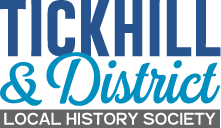

Tickhill School in 1764
Why 1764? This was the year when the Archbishop of York, Robert Hay Drummond, undertook a Visitation of all the parishes for which he was responsible. The Visitation required clergy to submit returns to 12 sets of questions about their parishes. One of the sets of questions was about the provision of schools and so there is a fair amount of information about schools, or lack of them, in 1764.
The responses from the Revd John Elam, Vicar of Tickhill, reveal the following:
· Tickhill had a 'publick school' endowed with £4 10s annually, but it was not known by whom it was founded.
· The school was repaired by the town.
· The Vicar was the master licensed to run the school.
· About 30 boys and girls were taught English and writing there.
· The pupils were not clothed, maintained or lodged by the school.
· Care was taken to instruct the children in the principles of Christianity and bring them to Church.
· Other benefactions to assist Tickhill children included Jane Farmery's bequest of £1 for school learning for 3 poor Tickhill boys and Robert Damm left 3s 4d in his will to buy books for poor children.
How typical was Tickhill in 1764 in having a school with these features? The Visitation returns show that the majority of parishes in this area including Armthorpe, Cantley, Conisbrough, Edlington, Sprotbrough, Stainton and Warmsworth had no schools. Some parishes had ad hoc arrangements. In Wadworth, for example, the Vicar taught some children in part of the vicarage. Where schools existed they depended on donations and endowments, sometimes from royalty (George I founded a free grammar school in Sheffield) or from aristocrats such as the Earl of Scarbrough who gave money to a school for about 20 children in Maltby and Lord Rockingham who paid for 13 boys to be clothed and taught in the school house at Swinton. More endowments came from parishes and local people. At Whiston a charity school was built at the parish's expense some 30 years earlier. A further bequest generated £6 a year, charged upon land in Tickhill, to teach 12 children of the poorest people in Whiston parish to read, write and 'accompt' and to provide the children with books including Bibles. In Doncaster the corporation gave the public school £50 annually.
Apart from grammar schools where Latin and Greek were taught by men who were not necessarily ordained, the teachers were usually vicars, curates or parish clerks teaching reading, writing and the principles of Christianity, with accounts or arithmetic in some cases. Women were employed either to teach girls to spin, sew and knit, or to teach girls and boys the rudiments of reading in 'petty' [dame] schools.
Most schools did not clothe their pupils, but at Wakefield's charity school, founded in 1700, each boy received a cap, coat, breeches, stockings, shirt and 2 pairs of shoes while each girl received a cap, collar, gown, stockings, shift and 2 pairs of shoes. The 70 children were taught English and writing with the girls also taught sewing and knitting. In York two charity schools for boys and girls were founded in 1705; they were known by the pupils' outfits: the Blue Coat School for boys and the Grey Coat School for girls.
Children in Tickhill were more fortunate, then, than children in many parishes in having the possibility to become literate, although arithmetic was not on offer in 1764 nor were handicrafts. It is likely that more boys than girls benefitted from the local school: of 125 couples of this parish who married at St Mary's Church between 1770 and 1789, 81 bridegrooms signed their names but only 48 brides were able to do so, the others making a X mark in the Parish Marriage Register.
Information about 1764 comes from Annesley, C. and Hoskin, P. eds Archbishop Drummond's Visitation Returns 1764, Vol 1 Yorkshire A-G (1997), Vol 2 Yorkshire H-R (1998), Vol 3 Yorkshire S-Y (2001), Borthwick Institute of Historical Research. The only other 18th Century Visitation returns to survive come from 1743. In these returns (which have fewer details than those of 1764) the Revd Elam described Tickhill's school as a 'publick grammar school' and noted that he kept a master under him to teach English. For a transcript of Tickhill's 1743 return see Yorkshire Archaeological Society Record Series, Vol 75, 1929, pp156-157.